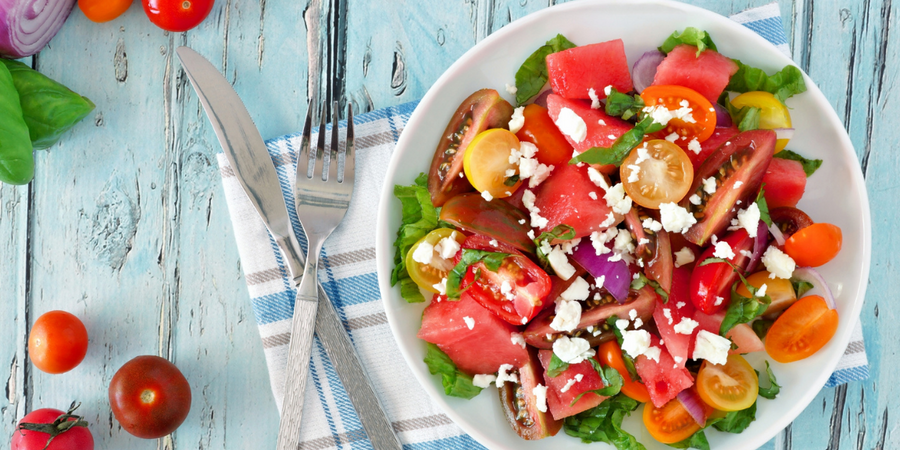Contact
Lindsey Sexton
Social Media Coordinator
Phone: 501-671-2398
Email: arsnaped@uada.edu
How to Choose a Watermelon

Why can't I pick a ripe watermelon?
Recently a friend of mine bought 2 seedless watermelons that were flavorless and had white crunchy veins in them. So she bought a seeded one, cut into it and fermented juices ran out! Has this ever happened to you? Imagine getting excited about the first fresh taste of summer only to find a messy disappointment. Yuck!
Pick a ripe watermelon every time in 2 easy steps.
Step 1: Look for melons that are heavy for their size and have a firm rind. Remember, watermelon is mostly made of water. So if it feels light, that means your main ingredient is lacking.
Step 2: Turn the melon over and look at it’s underside, which sits on the ground. This field spot should be yellow or cream colored, indicating the watermelon was allowed to ripen in the field before harvesting. If it is white or pale green the melon was harvested too early. If grown hydroponically, there will not be a field spot on it’s underside and the watermelon should be labeled as such.
Watermelons do not continue to ripen after they have been removed from the vine. So, they should be harvested when they are ready to eat. No amount of thumping, taping, sniffing, or shaking accurately indicates ripeness. Depend on what you see to help you choose the best watermelon.
Remember, to wash your watermelon
When you get your melon home make sure you wash it before you cut into it. All fruits and vegetables should be washed under clean, running water before eating them. This is true whether you plan to eat the outside of the produce or not. You should also use clean knives and cutting surfaces, and make sure you have washed your hands prior to preparing the watermelon for eating.
How to store watermelon
Once picked, uncut watermelon can be stored up to 10 days at room temperature - 75 °F or below. Uncut watermelons have a short refrigerator life, so store at room temperature until ready to chill and eat. Tightly cover cut pieces in an airtight container and store in the refrigerator for 2 to 3 days.
What to do with a bad watermelon
If buying from a farm stand or local grower, make sure you know their return policy before buying. If you get an unripe or over-ripe watermelon home, take it back and exchange it for another one or ask for your money back. Most grocery stores will refund or replace the melon. It is best if you have your receipt with you.
Why should I eat watermelon?
Not only are watermelons delicious and refreshing, they are low in calories and very nutritious. Watermelon is high in lycopene, second only to tomatoes. Lycopene is a powerful antioxidant and is effective in preventing some forms of cancer and cardiovascular disease.
Watermelon is also high in Vitamin C and Vitamin A, in the form of disease fighting beta-carotene. Research suggests that the red pigmented foods provide this protection.
Potassium is also present, which helps control blood pressure and possibly prevent strokes.
Nutrition Facts per 1 cup serving
Calories 46
Protein 1 g
Carbohydrates 11.5 g
Fat 0 g
Fiber .5 g
Sodium 1.5 mg
Watermelon Tomato Salad

Combine watermelon and tomatoes for a refreshing summertime treat. This dish is great way to make vegetables part of your breakfast and fruit part of your dinner.
Serves 12
- 5 cups seeded watermelon, cut into 2-bite-sized cubes
- 1 1/2 pounds ripe tomatoes, cut into 2-bite sized cubes
- 3 teaspoons sugar
- 1/2 teaspoon salt
- 1 small red onion, quartered and thinly sliced
- 1/2 cup apple cider or red wine vinegar
- 1/4 cup vegetable or canola oil
- black pepper to taste
- Combine watermelon and tomatoes in a large bowl; sprinkle with sugar and salt, tossing to coat. Let stand 15 minutes.
- Stir in onion, vinegar, and oil. Cover and chill 2 hours. Serve chilled, if desired. Sprinkle each serving with black pepper to taste.
Calories 70
Fat 4.5g
Protein 1g
Fiber 1g
Sodium 105mg
Carbohydrate 8g
Cook's Note
Lettuce leaves, feta cheese, and chopped mint are optional garnishes and not included in the recipe analysis.